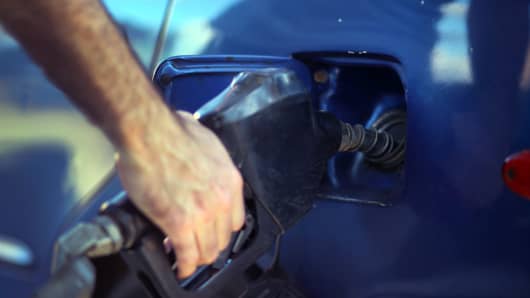Why gasoline could spike 10 percent in the near future
By: Patti Domm | CNBC Executive News Editor
|
|
|
This could send oil prices soaring
Wednesday, 12 Feb 2014 | 1:00 PM ET
CNBC's Patti Domm looks at the real wild card for oil prices, which are at a four-month high.
Gasoline could jump anywhere from 15 to 40 cents a gallon over the next several months, but it could be one of the cheapest summer driving seasons in several years.
GasBuddy.com predicts that more expensive gasoline is on the horizon, as refiners go into annual maintenance mode for the shift to summer fuels. Regular gas has averaged $3.30 per gallon so far this year, the cheapest opening 45 days since 2010 and 6 cents below last year's price.
But GasBuddy forecasts the national average will rise by 15 to 40 cents per gallon by Easter Sunday—April 20.
Part of the reason is due to what it describes as an "extensive" refinery turnaround schedule, already underway on the Gulf Coast.
Two major northeast refineries on the Delaware River are also down for maintenance and the Irving refinery in St. John, New Brunswick, a big contributor to East Coast gasoline, is expected to go down for maintenance in late February and most of March, according to GasBuddy.

Getty Images
"2014 is going to bring lower prices on average than 2013 but its complicated," said Tom Kloza, chief oil analyst with GasBuddy.com.
"I do think it will qualify as a spike, but one thing we'll see is it won't have the duration as in previous years, or be as spectacular as in previous years. If we get a spectacular increase in 2014, it will have to be hurricane inspired and come in the second half," Kloza said.
Other factors include increased exports of gasoline and other refined products and less output from European refineries.
West Texas Intermediate and Brent crude, meanwhile have been moving higher, driven in part by stronger demand from China and reduced Libyan capacity. John Kilduff of Again Capital said WTI is also being pulled higher by strong distillate demand, also driving heating oil prices higher.
"Brent is under more pressure than WTI in the current environment. It should probably touch $110 again before it's all over here," Kilduff said. "It should be a precipitous pullback in the time period before the driving season really starts to come into focus, and some of the supply issues start to resolve themselves. It's sort of a round-robin of output issues."
Kilduff says based on his forecast for crude prices, he does not expect the jump in gasoline prices to be that high.
Even with that quick spike in retail gasoline prices forecast by GasBuddy, the increase is likely to be below average for the annual winter-to-spring switchover. GasBuddy says the average gain in futures prices has been 57 percent in the last 30 years, which would be $1.40 per gallon, but GasBuddy expects a much smaller rise and a 25 percent rally could put futures at $3.10 per gallon.
Kloza said the export of gasoline is increasing and makes the U.S. supply more vulnerable if there is a hurricane that shuts down refineries. He said the areas impacted by the highest prices last year—like the Upper Midwest and Minnesota—will be well-supplied this summer. But the areas that could be hit with higher pump prices are the Northeast, California, and for a briefer time, the Southeast.
More shipments are going to Asia than has been seen in the past. "What popped up on my radar is we sent it to China, we sent it to Japan and we sent to Korea in November," Kloza said, adding refined products are typically sent to Latin America. "It's the first time I saw that much going to Asia."
The national average price for a gallon of unleaded gasoline was $3.31 at the pump Wednesday, according to AAA.
Gasoline futures, meanwhile, were higher Wednesday after a Department of Energy data report showed a much greater-than-expected drop in fuel stocks. Gasoline stocks were off by 1.9 million barrels, well above the 100,000 expected. Futures were at $2.76 per gallon in afternoon trading, a gain of 0.6 percent.
But WTI crude came off its highs after Energy Information Administration data showed a larger-than-expected build in stockpiles. WTI reached a high of $101.38 per barrel early Wednesday, its highest level since October.
Brent, the international benchmark, was also higher, driven Wednesday by reports that Chinese demand surged 11.9 percent to record levels of 6.63 million barrels per day in January. OPEC also raised its expectations for 2014 demand growth by 50,000 barrels a day—now a gain of 1.1 million barrels to 90.98 million barrels a day.
While the gains in Chinese imports could be short-lived, the report added to positive sentiment.
Gene McGillian, analyst with Tradition Energy, also expects WTI to reverse direction, but not yet.
"I think right now we are headed higher still," he said, adding the only thing that would derail it is a surprise economic report or action by the Fed. "The market is going to edge higher. I don't think we have a rally in the making, especially with the maintenance programs starting up, but we could probably tack on with momentum, another $3 to $5 to this latest move."
He said new speculative longs came into the market at $97 to $100. "There is a perception the economy is continuing to improve, maybe the economy is on a stronger footing," he said.
The refinery maintenance programs reduce the demand for WTI and that should lead to lower prices, and the release of more crude from the hub in Cushing, Okla., via the new Keystone pipeline should also make more oil available, and weigh on prices.
No comments:
Post a Comment